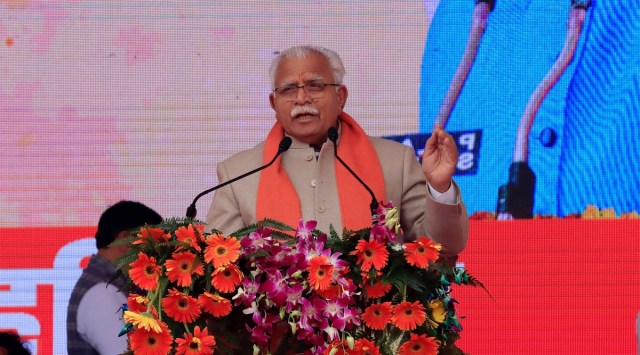Haryana decides to regularise 450 unauthorised colonies, including those outside municipal limits
The Haryana government is also considering to regularise 1,856 more colonies which to be announced soon
 Haryana Chief Minister Manohar Lal Khattar. (Express Archives)
Haryana Chief Minister Manohar Lal Khattar. (Express Archives) The Haryana government Thursday decided to regularise 450 unauthorised colonies, including those that are located beyond the municipal limits. The government is also mulling regularisation of 1,856 more unauthorised colonies and a decision on the same will be taken soon, said officials, adding that a roadmap is currently being formulated.
The 450 unauthorised colonies include 59 in Faridabad, 16 in Fatehabad, three in Gurgaon, 20 in Hisar, 25 in Jhajjar, 30 in Kaithal, two in Karnal, 25 in Kurukshetra, 35 in Nuh, 31 in Palwal, 22 in Panipat, 14 in Rewari, 32 in Rohtak, nine in Sirsa, 35 in Sonipat and 92 in Yamunanagar.
Chief Minister Manohar Lal Khattar said, “Of the total 450 colonies that have been decided to be regularised, 239 fall under the Town and Country Planning Department’s purview and 211 are under the jurisdiction of the Urban Local Bodies Department. With this addition, a cumulative total of 1,135 unauthorised colonies will have been regularised since 2014.”
Khattar added that among the 1,856 unauthorised colonies the government is mulling to regularise are 727 colonies under the Town and Country Planning Department while the rest are under the purview of the Urban Local Department. “The regularisation process will commence once the specified criteria are met within these colonies. This marks a crucial step in the state’s urban planning and development efforts,” Khattar added.
“The Congress government, during its ten-year tenure, had regularised 874 unauthorised colonies. However, the present government has taken a different approach, focusing on citizen convenience by relaxing the norms for regularisation. We reduced the requirements for approach roads and internal road widths to enable the eligibility of regularisation. Under the new norms, colonies with an approach road width of six meter or more and internal road width of three metre or more are now eligible for regularisation,” Khattar said.
The Chief Minister further added, “Residents living in unauthorised colonies beyond municipal limits have long been devoid of essential amenities and while acknowledging these long pending difficulties, the government has undertaken the task of regularising these colonies.”
Khattar also said, “A dedicated committee examined the infrastructure requirements for vital services and civic necessities in the colonies situated beyond the municipal zone. Subsequently, a series of recommendations were put forth to address these issues and improve the living conditions for the affected population. On the basis of these recommendations, we have decided to regularise isolated colonies having a minimum area of two acre. This move is anticipated to bring about a transformative change in the lives of the residents living in these areas.”
Procedure
Talking about the process of regularisation, an official said, the Member Secretary (Convener) of the District Town Planning (DTP) Committee of a district is empowered to oversee the regularisation of colonies situated outside municipal areas.
To initiate the regularisation process, interested parties must submit their applications to the Convener, who will then forward these applications to the District Level Scrutiny Committee (DLSC) for review.
The government has decided to consider applications submitted not only by registered Citizen Welfare Committees but also by the developers or a minimum of five colony residents.
Upon meeting the specified criteria, societies can then proceed to be registered under the relevant provisions.
Road width and commercial area criteria
Urban planning and regulations governing residential colonies have been introduced. Under this, residential colonies have been categorized into ‘A’, ‘B’, ‘C’ and ‘D’ categories, each with specific criteria to enhance their development and organisation. One of the key requirements for ‘A’ and ‘B’ category colonies is the provision of at least a six-metre-wide road for access. Internal roads within these colonies are mandated to have a minimum width of three metre, ensuring smoother intra-colony movement.
For the ‘C’ and ‘D’ category colonies, the consideration of applications even if the main road width varies has been introduced. This flexibility aims to accommodate diverse layouts while maintaining the overall quality of infrastructure.
Residential colonies, in which commercial areas are developed more than four per cent or allotted or registered for commercial activities, will also be regularised with additional charges. But it will not include malls, multiplexes, hotels and banquet halls etc.
The development charges fixed to regularise the residential colonies falling outside the municipal area will be 8 per cent of the collector rate for undeveloped land and 5 per cent of the collector rate for developed land.
The commercial area will be 4 per cent and three times of the development fee will be payable on the commercial areas exceeding this limit. The collector rate will be equal to the rates of the collector rate applicable to the agricultural land falling in the residential zone of the development plan. The development fee in the municipal area will be 5 per cent for all types of areas.
For disposal of cases outside the municipal area, the DLSC chairman has been made the final authority, while in the municipal area, these powers will be with the Divisional Commissioner.
The state government had already banned menial jobs in such colonies. Therefore, before July 1, 2022, those who had registered the Sale Deed Agreement to sell will be considered as sold.
Provision of parks, open spaces and community halls up to 500 square metre will be made to create a better living environment in colonies with an area of more than 20 acre. For this, special attention will be given to those colonies in which the area owned by the developer has not been sold.
Fire norms in these colonies for which the developer/RWA Necessary arrangements will be ensured by the Fire Department. In this regard, the developer/RWA will inform the Deputy Commissioner and District Town Planner.
The present condition of all the houses already built in these residential colonies will be maintained, said an official.
Development works of the colonies which fall outside the municipality area will be done by the Haryana Rural Development Authority. The development work of the colonies located within the municipality will be done by the municipality concerned.











